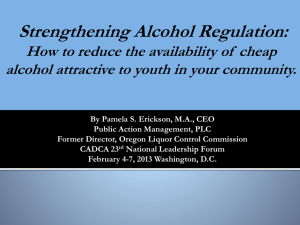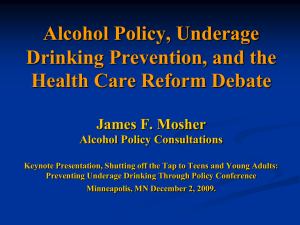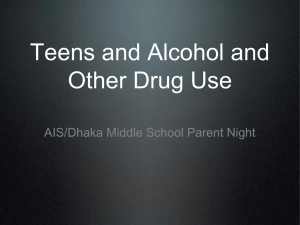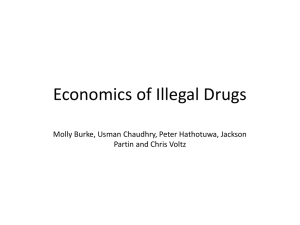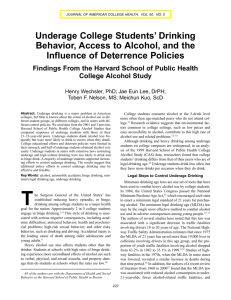Underage Drinking, Respect for the Law, and Fitting In
advertisement
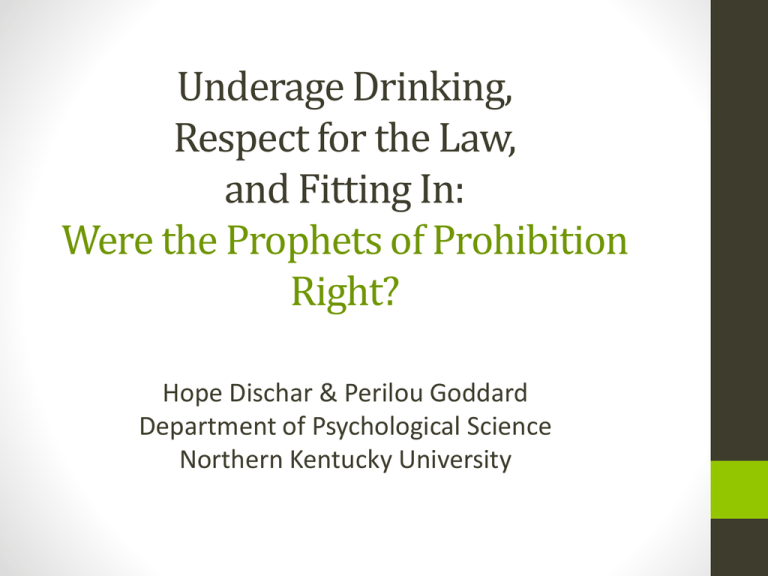
Underage Drinking, Respect for the Law, and Fitting In: Were the Prophets of Prohibition Right? Hope Dischar & Perilou Goddard Department of Psychological Science Northern Kentucky University • Prohibition (192033) challenged our notion of ourselves as law-abiding citizens • Widespread disregard for the laws of Prohibition were thought to undermine respect for all law • More Prohibition fallout • Law breaking went from marginalized to mainstream behavior Parallels of Prohibition Today • Underage drinking • Nearly 10 million underage drinkers in 2010 (SAMHSA, 2010) • Marijuana use • Nearly 17.4 million pastmonth marijuana users in 2010 (SAMHSA, 2010) Hypotheses • Underage drinking and marijuana use would be associated with • less respect for the law • greater sense of “fitting in” with mainstream society Participants and Procedure • Participants • 162 undergraduates 18 to 20 years old • 105 females, 57 males • 10% were African-American, 3% were Hispanic, and 79% were White • Procedure • Participants completed all measures anonymously in 50-minute live sessions (not online) • Consent form, questionnaires assessing each of the relevant variables, and debriefing Measuring Alcohol and Marijuana Use • We created indices based on self-reported frequency of use • • • • • 1: Have never used 2: Have not used in past year 3: Have used in past year but not in past month 4: Have used on fewer than 10 days in past month 5: Have used on 10 days or more in past month Measuring Respect for the Law • Respect for the Law Scale developed for this study to tap beliefs about the legitimacy of the law • 16 statements rated on 7-point Likert scales • 1 = strongly disagree, 7 = strongly agree • Representative items • Laws in the U.S. are best described as “of the people, by the people.” • We have the ability to change the laws we don’t agree with by voting for officials who will represent our views. • We are obligated to obey the laws because we help make the laws. • Moderate internal consistency (α = .84) Measuring the Sense of “Fitting In” • Scale developed by Cozzarelli & Karafa (1998) to measure the similarities between individuals’ personal beliefs/values and their perception of American beliefs/values • 9 statements rated on 7-point Likert scales • 1 = strongly disagree, 7 = strongly agree • Representative items • I strongly identify with American values. • I feel that many of my values are more or less universal. • Moderate internal consistency (α = .80) Alcohol Use National vs. NKU Data Alcohol Lifetime Prevalence Alcohol 12-month Prevalence NSDUH data 85.7% 78.7% NKU data 82.7% 77.2% • NSDUH data (2010) were calculated for persons aged 18 to 25 • NKU data included ONLY 18- to 20-year olds Marijuana Use National vs. NKU Data Marijuana Lifetime Prevalence Marijuana 12month Prevalence NSDUH data 51.1 % 29.8% NKU data 54.3% 43.2% • It’s pretty clear that lots of NKU students like their cannabis! Hypothesis 1: More frequent underage drinking and marijuana use will be associated with less respect for the law Correlation with Respect for Law Scale p value Underage Drinking Index -.14 .069 Marijuana Use Index -.20 .010 The hypothesis was partially supported: Marijuana use was significantly associated with less respect for the law, but underage drinking was not (at least not quite). Hypothesis 2: More frequent underage drinking and marijuana use will be associated with a greater sense of “fitting in” Correlation with “Fitting In” Scale p value Underage Drinking Index .31 <.001 Marijuana Use Index .06 .429 Again, our hypothesis was partially supported: More frequent underage drinking was significantly associated with greater feelings of “fitting in,” but marijuana use was not. Conclusions • The prophets of Prohibition were partially right • Students who regularly violated the prohibition against marijuana showed significantly less respect for the law • However, frequent underage drinkers did not • Perhaps drinking by underage college students is so normative that they don’t even think of it as breaking the law Conclusions • Our data about fitting in are consistent with this explanation • The more frequently underage students drank, the more they felt they fit in with mainstream America Implications • There is strong evidence that minimum legal drinking age laws have some benefits • e.g., reduced motor vehicle deaths • However, these laws clearly do not serve as effective deterrents to drinking for many young people • Perhaps it’s time to think more creatively about policies to reduce drinking-related harms without focusing so much on the legality of the drinking age



